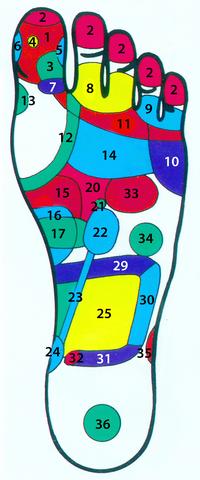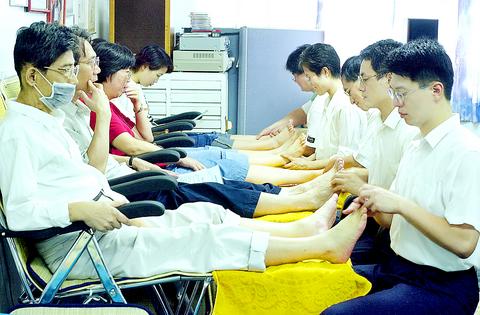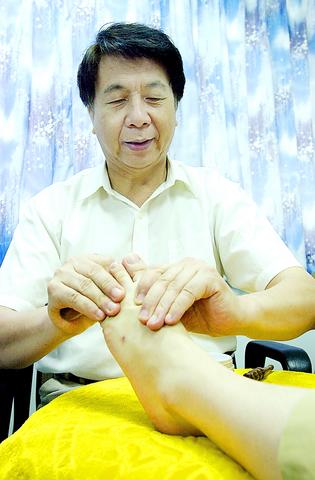Inside the long storefront windows lie a row of big comfortable couches on which a dozen customer are reclined. In front of them, massage therapists are concentrating on their customers' feet. Using only their hands, a wooden massage bat and some cream, they swiftly press, push and rub. Some of their Japanese customers give out groans of pain -- "Itai! Itai! Itai!" -- but most customers, foreign or local, seem to enjoy it. Three young Japanese women take pictures of each other while being massaged, their fingers stretched in a "V" gesture while their faces remain pinched in pain.
"Taiwanese foot massage is very famous in Japan. I heard it's more painful than in Thailand and other countries. I like it," said 24 year-old Yasuko Shishido.

Shishido was in Taipei for just a day and kept busy tasting local dumplings, sampling Oolung tea and pineapple cakes and was eager to get in a foot massage before having to leave Taiwan.

PHOTO: CHEN CHENG-CHANG, TAIPEI TIMES
"I come to Taiwan for business twice a year and always come here, however busy my trip," said 60-year-old Tuneo Iwane, another Japanese customer at this foot massage parlor.
For many Japanese tourists, Taiwan's attractions aren't only the Palace Museum and Chiang Kai-shek Memorial Hall, but the masochistic pleasure of foot massage.

PHOTO: CHEN CHENG-CHANG, TAIPEI TIMES
Walking along Taipei's Minchuan East Road or Linsen North Road, there can be seen more than a dozen foot massage parlors, each with a huge, eye-catching sign of a colorfully diagrammed foot. Many of them bear the name Father Wu Foot Massage.
Father Josef Eugster from Switzerland, who goes by the Chinese name Wu Ro-shih (吳若石), said the parlors and their popularity are something he would never have thought of 23 years ago, when foot massage was a simple self-help therapy. It was more than two decades ago when he "re-discovered" and began promoting the practice that can be found in the ancient histories of China and Egypt, a therapy known as foot reflexology.
A month ago he held a press conference clarifying to the public for the first time that he had never authorized anyone to use his name as a trademark, nor is the colorful foot diagram of his making. The phenomenal success of foot reflexology in Taiwan makes Eugster proud, but at the same time worried.
After arriving in Taiwan 30 years ago to preach in Taitung, Eugster became bothered by arthritis. Another Swiss priest gave him a book about foot reflexology titled Good Health for the Future (1976), by Heidi Masafret. He studied the book and experimented on himself. Pleased with the results, he began practicing on his disciples to help them with their own health problems, but also as a way to spread the gospel.
According to theories expounded on by Eugster and Eugene Cheng (
Reflexology theory divides the foot into 26 bones and five major reflex areas. To massage the foot is to stimulate the problematic organs or "push away the pathological sediments," Eugster said.
Cheng also combines reflexology theory with Chinese medicine's five-elements concept in practicing foot massage. For example, if one feels pain or sediment when pressing on one part of the left sole (see diagram, area 33), it is an indication of a heart problem. According to the five-elements theory, the heart belongs to the fire element, so in addition to the heart, the reflex areas of the intestine and liver must also be massaged in order to maintain a healthful balance.
After considerable local and international media coverage 20 years ago, Eugster gained fame and a flock of foot-massage followers. Shuttling from workshops to hospitals and speaking engagements, the fruit of Eugster's work can be seen in nearly every city in Taiwan, with around 1,000 foot massage parlors on the island, according to Cheng. And it's become more popular, losing its focus on therapy and becoming more of a superficial consumer fad.
It's also become a huge money-making enterprise lacking in regulation. Some parlors have developed into multi-function health centers. In addition to offering foot massage, one parlor called Tsai Chun Kuan (
Tsai Chun Kuan has also contracted with several travel agencies to bus tourists directly to the parlor. Tourists pay NT$700 for a half-hour foot massage, NT$200 of which goes to the travel agents. For Japanese, it's still a reasonable price compared with what they would pay in Japan.
Currently in Taiwan, the price for a foot massage is between NT$500 and NT$700 for 30 minutes. There is no regulation of price or quality, which can vary widely.
Lu Wan-ping (
Since 1984, the Cabinet-level Department of Health (
The ROC Foot Reflexology Association, founded by Cheng and Eugster, is the only group in Taiwan that certifies massage therapists in their chosen trade. But there remains a void of institutionalization on the correct practice and technique of foot reflexology, according to Cheng.
"If they want to use my name, they have to employ my standard of skill and quality of practice," Eugster said. "I'll have to train them myself."

This month the government ordered a one-year block of Xiaohongshu (小紅書) or Rednote, a Chinese social media platform with more than 3 million users in Taiwan. The government pointed to widespread fraud activity on the platform, along with cybersecurity failures. Officials said that they had reached out to the company and asked it to change. However, they received no response. The pro-China parties, the Chinese Nationalist Party (KMT) and Taiwan People’s Party (TPP), immediately swung into action, denouncing the ban as an attack on free speech. This “free speech” claim was then echoed by the People’s Republic of China (PRC),

Exceptions to the rule are sometimes revealing. For a brief few years, there was an emerging ideological split between the Democratic Progressive Party (DPP) and Chinese Nationalist Party (KMT) that appeared to be pushing the DPP in a direction that would be considered more liberal, and the KMT more conservative. In the previous column, “The KMT-DPP’s bureaucrat-led developmental state” (Dec. 11, page 12), we examined how Taiwan’s democratic system developed, and how both the two main parties largely accepted a similar consensus on how Taiwan should be run domestically and did not split along the left-right lines more familiar in

Specialty sandwiches loaded with the contents of an entire charcuterie board, overflowing with sauces, creams and all manner of creative add-ons, is perhaps one of the biggest global food trends of this year. From London to New York, lines form down the block for mortadella, burrata, pistachio and more stuffed between slices of fresh sourdough, rye or focaccia. To try the trend in Taipei, Munchies Mafia is for sure the spot — could this be the best sandwich in town? Carlos from Spain and Sergio from Mexico opened this spot just seven months ago. The two met working in the

Many people in Taiwan first learned about universal basic income (UBI) — the idea that the government should provide regular, no-strings-attached payments to each citizen — in 2019. While seeking the Democratic nomination for the 2020 US presidential election, Andrew Yang, a politician of Taiwanese descent, said that, if elected, he’d institute a UBI of US$1,000 per month to “get the economic boot off of people’s throats, allowing them to lift their heads up, breathe, and get excited for the future.” His campaign petered out, but the concept of UBI hasn’t gone away. Throughout the industrialized world, there are fears that